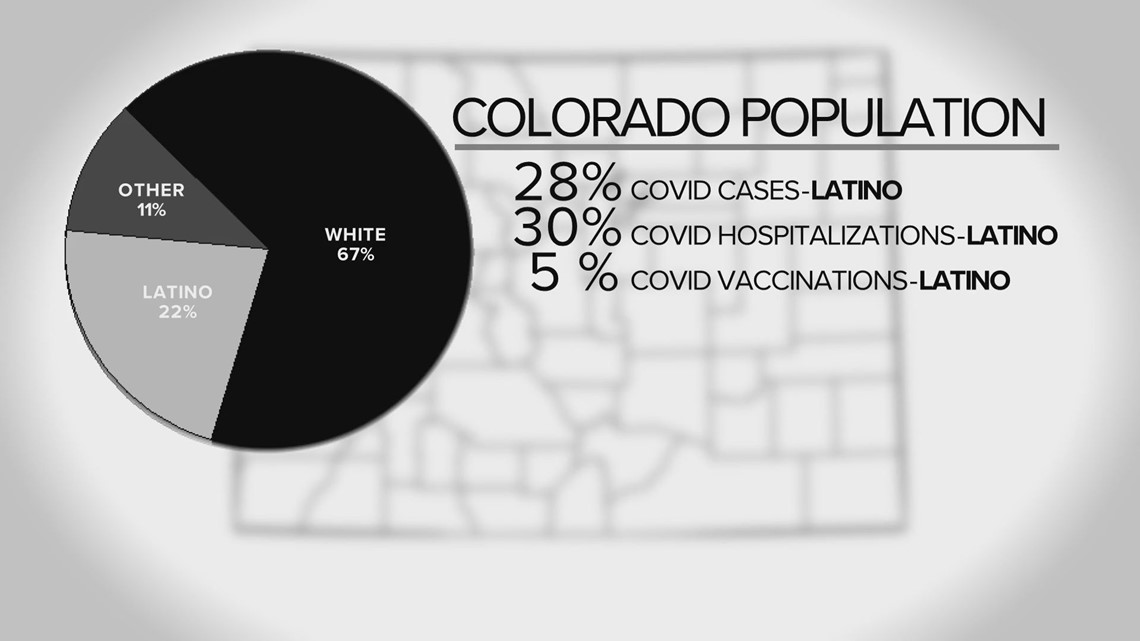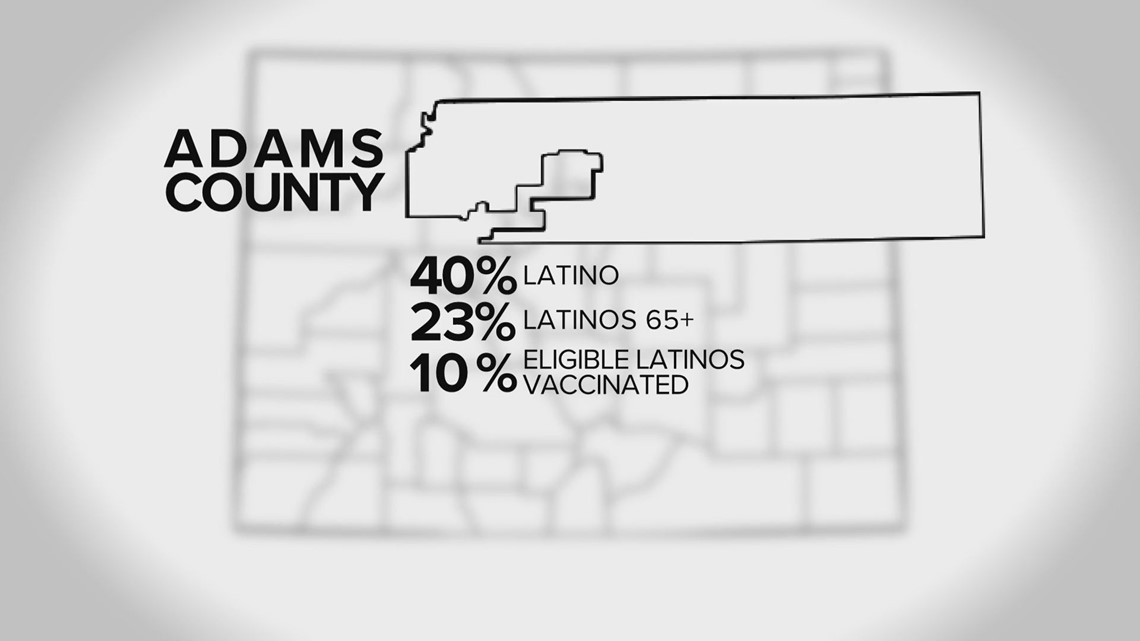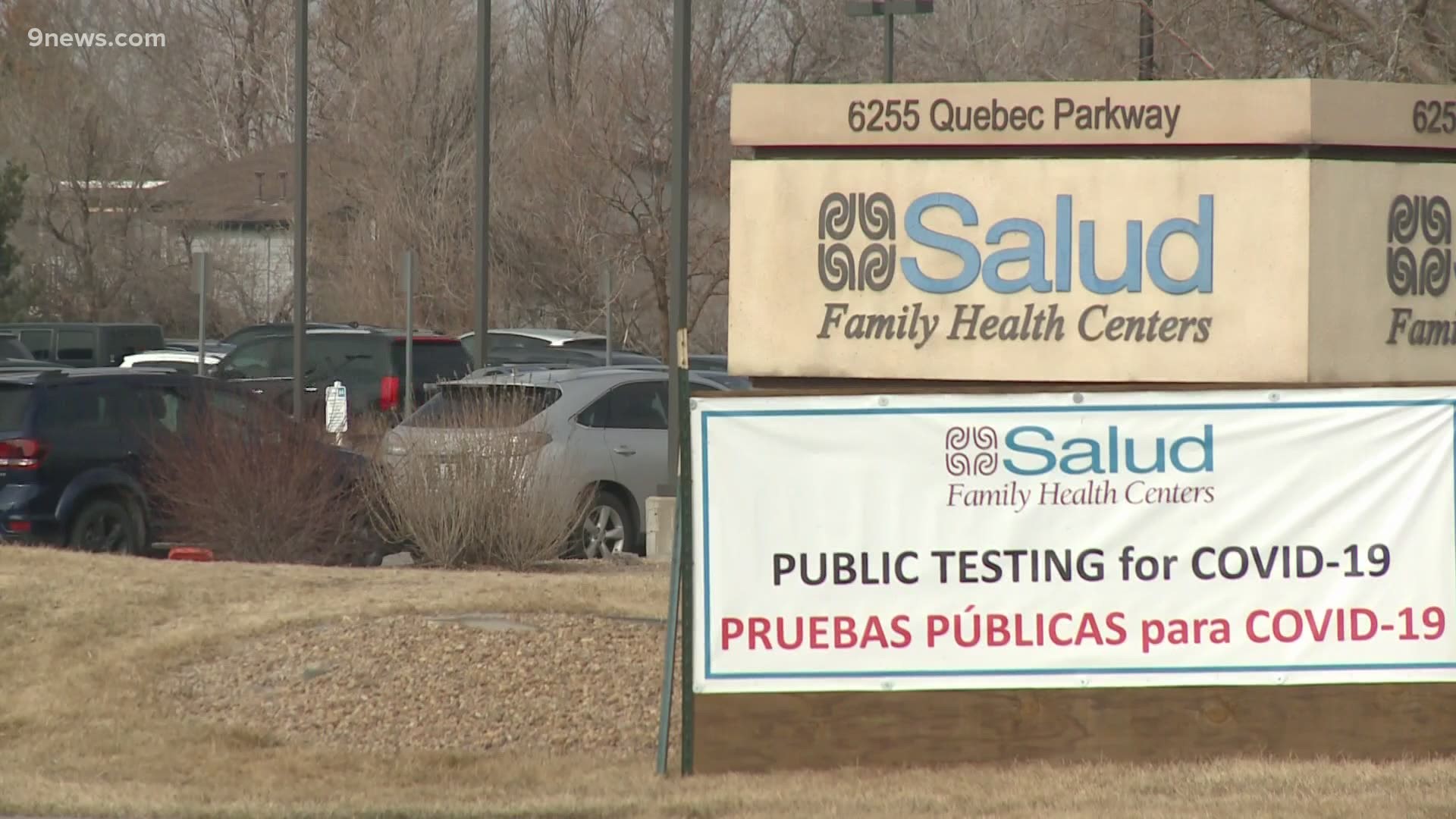COLORADO, USA — Latino Hispanic Coloradans are not being equitably vaccinated compared to their U.S. Census population size in the state, according to a 9Wants to Know analysis of Colorado Dept. of Public Health & Environment (CDPHE) data that looked at vaccine distribution numbers.
CDPHE’s website says the COVID-19 vaccine is currently available for healthcare workers, frontline workers, teachers and Coloradans 65 and older.
According to the Kaiser Family Foundation, 60% of healthcare workers are white and 13% are Hispanic nationally.
In eight of the 11 counties where racial data was provided by CDPHE, there was a double-digit gap between the Latino population and the percentage of Latinos vaccinated.
Statewide vaccination trends
Shortcomings in the county distribution data are mirrored by trends at the state level. According to the Census, Hispanic Coloradans account for 22% of the population, and 10% of the state’s 65 and older population identifies as Latino.
As of Feb. 22, CDPHE data shows less than 5% of the vaccine has gone to Hispanic Coloradans.
Brandy Emily, deputy director of the immunization branch of CDPHE, said the health department is aware of the disparities and is making strides to fix it.
“We’re committed to distributing the vaccine as efficiently and equitably as possible,” she said. “We see the numbers and we are putting in the work to close that gap.”
Emily said CDPHE is trying to accomplish this through a variety of strategies, including partnering with medical professionals of color to be “champions of the vaccine,” and coordinating transportation for those that can not easily get to vaccine appointments.
In a news release Monday, CDPHE said 20,890 doses at 66 vaccine equity clinics will be completed by the end of Tuesday. The Vaccine Equity Outreach team is trying to schedule more than 175 clinics across Colorado. The goal is to partner with organizations in the community to distribute doses to “disproportionately impacted communities.”
Bearing the brunt of the pandemic
Hispanic residents have been more likely to get sick with the virus and hospitalized for it.
Colorado's population is 22% Hispanic. However, CDPHE data shows 28% of all COVID-19 cases and 30% of hospitalizations are Hispanic Coloradans.
In other words, Hispanic Coloradans represent 2-in-7 COVID-19 cases and 2-in-10 COVID-19 hospitalizations.


Deaths from COVID-19 are more aligned to the ratios of the state.
As of Feb. 8, Black Coloradans account for 5% of the population and 3% of deaths.
Hispanic or Latinos account for 22% of the population and 20% of deaths.
White Coloradans make up 68% of the population and 64% of deaths.
Black Coloradans also account for 3% of COVID-19 cases and 6% of hospitalizations.
And white Coloradans account for 41% of cases and 53% of hospitalizations.
White people are getting more of the vaccine
In eight of 11 counties, white residents got more of the vaccine. For example, in Weld County, 65% of residents are white, and 81% of the vaccine went to white people.
Colorado population's is 68% white, and it makes up 41% of COVID-19 cases and 53% of hospitalizations as of Feb. 8.
Adams County, Salud Family Health Centers work to close gap
Dr. Tillman Farley, chief medical officer at Salud Family Health Centers that serves a large part of northeastern Colorado, said many vaccine clinics are seeing more higher-income, white people coming to get the vaccine.
"I think across the country, every COVID vaccine clinic is seeing a lot of higher-income white folks gaining access disproportionately more than the folks who are most adversely affected by the virus," he said
Farley said 70% of his patients are people of color.
"We found that the people coming to our vaccine clinics were a somewhat different demographic than our patient population, a lot more Anglo folks and people that are in a higher socioeconomic status," Farley said.
In Adams County, 23% of the 65-and-older population is Latino — 10% of Latinos received at least one does of the vaccine as of Feb. 8.


“Work is not done, and this data is probably evidence of how much there is to do,” said Kaitlin Wolff, a public health nurse for the Tri-County Health Department.
Wolff, who is also involved in vaccine deployment for Adams County, said she credits a combination of systemic issues and the racial/ethnic makeup of those first in line for the vaccine for the disparity in Adams County.
“If you have historically marginalized communities, making vaccine access dependent on transportation or tech-savvy or English language skills – people will benefit from certain groups over others,” Wolff said.
The Adams County commissioners are looking for partners in marginalized communities to host vaccination clinics, Wolff said.
"The thing we do not want to have happen is that vaccine access is yet another health disparity, or yet another service that widens the gap based on race and ethnicity," Farley said.
Salud has focused on text messages and calls to their patients 65 and older in both Spanish and English. With increased marketing, outreach at predominantly Black and Latino churches, working with health promotion community organization Promotoras and through community leaders, Farley said it's starting to pay off.
Farley said he is concerned about the gap in vaccine distribution, but he said he is not yet worried.
"The Latinx population is younger, and most of them are probably not in the age group yet to be vaccinated," he said. "I’ll be more worried as we expand it out farther to more age groups. We’re going to do everything we can to even it out, but to even it out requires significant extra work on our part."
Some vaccine race data is unknown
Sixteen percent of vaccine recipients do not have a race or ethnicity recorded in the CDPHE vaccine data.
Wolff said the percentage of vaccine recipients with an unknown race or ethnicity could be because people choose not to give that information, or because distribution partners may not enter it in the state’s database that tracks who gets the vaccine.
SUGGESTED VIDEOS: COVID-19 Vaccine

